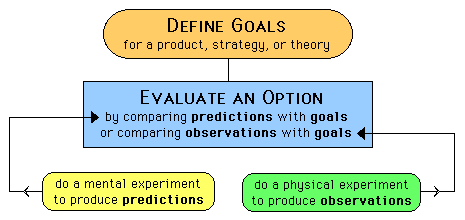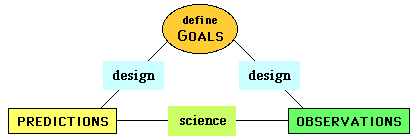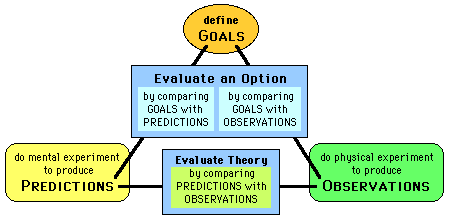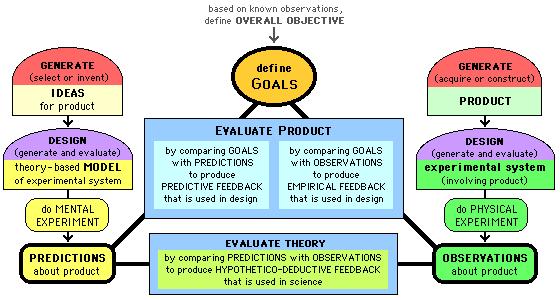
An Introduction to Design
by Craig Rusbult, Ph.D.
This page has not been revised
since January 2001, but
the version on another website has been revised many times
since then, so I strongly recommend that you read
THE
REVISED VERSION.
The goal of this page is to help you
understand and enjoy the exciting adventure of design, and
improve your ability to recognize opportunities and solve problems.
This page is about Design Method and
its connections with Scientific Method.
To avoid time-wasting reloads, click this
link.
Table of Contents
for this page:
What is Design?
The Process of Design
Design and Science
Design Before Science
Products and Strategies
Is there a method?
visual summaries
What is design?
It is the process of using creativity and critical thinking to solve a problem.
What is a problem?
In the context of design, a problem is any situation where you have an opportunity
to make a difference, to make things better. Whenever you are thinking
creatively and critically about ways to increase the quality of life (or
to avoid a decrease in quality), you are actively involved in problem solving.
The overall goal of design can be a product,
strategy, or theory.
Broadly defined, this includes almost everything in life.
For example, although we usually think
of a "product" as an object (like a bicycle or refrigerator),
it also could be a repaired object (a car that now works better than it
did before), a work of art (like a painting, song, or story), a letter to
a colleague, an inspirational talk for a community group, or an educational
game or website. The product being designed and constructed might
even be the food you're preparing for a dinner party, a tasty casserole
for a potluck picnic, or an apple pie you're entering in a contest at the
county fair.
Similarly, you can design strategies
for a wide variety of situations -- including educational (as a learner
or teacher), social, romantic, athletic, political, military, legal, financial,
entrepreneurial, agricultural, and ecological -- involving competition and/or
cooperation. You can plan a strategy for winning a soccer game, running
a charity, or growing crops to feed a nation. Or the goal of a plan
may be to improve a personal or professional relationship, to make a friend
or be a friend, to plan a party or prepare for an interview.
Decision Making: When you make
personal decisions, you are designing a strategy for living, for the actions
that will help you achieve your goals in life. Similarly, business
decisions are strategies for achieving business goals, and so on.
Often, the design of a new product is
accompanied by strategies. For example, making and selling a musical
CD (a product) requires the coordinating of many strategies -- for artistic
research and development (searching for old songs by others, or writing
and arranging your own new songs) leading to evaluation and decision (about
which songs to record), and for rehearsing and performing, engineering and
production, manufacturing and marketing, distribution and sales -- to achieve
objectives that are practical, artistic, and financial.
And if you're opening a new restaurant,
making delicious food is just one part of a complete strategy. You'll
want to think about which combination -- of foods, atmosphere, service,
location, marketing, pricing,... -- will bring in new customers, send them
out satisfied, and keep them coming back for more.
The Process of Design
The first step in problem
solving is to recognize that a problem exists, because you have looked at
a situation as it is now, and you can imagine a future in which things have
changed and improved. Or perhaps you can imagine a future in which
things have changed but have not improved, and you want to avoid (or minimize)
these changes. Either way, if you want to take advantage of your opportunity
to make a difference, you will generate and evaluate ideas (and actions)
that will help you make progress toward a solution. These ideas and
actions are the focus of this section.
Imagine a "time machine" experience in which -- before the minivan was invented -- you are part of a design team whose objective is to develop this new type of car. The general method you will use for solving this problem -- for converting your ideas into reality so you can take advantage of the opportunities inherent in your ideas -- is shown below:

Why are you interested in designing
a minivan? Because, based on old observations,
you have decided that this is an idea worth developing. In making
this decision you have taken the first step in design, to define
an overall objective. In this case, the objective is to
design a minivan.
More specifically, you define
goals by asking "What do we want? What characteristics
(for what it is and what it does) should our product have?" /
For the minivan, you set goals for function (such as making it easy to remove
the seats, and to load large objects through the doors), performance (for
gas mileage, acceleration, handling, braking, crash safety,...), aesthetics
(so it looks good), human response (so lots of people will buy it), cost
(for the initial "factory changeover" and for each additional
car), plus criteria such as quality control and reliability.
You can generate ideas for options by
selecting an old product or inventing a new product. Usually, to invent
a "new" product you revise an old product. /
Your new minivan will have some old components (bodies and seats similar
to those in vans and station wagons, existing engines and transmissions,...)
that you will adapt and combine in creative ways.
Then you run an experiment
-- either in your mind to produce predictions
about what you think will happen, or in the real world to produce
observations about what really happens
-- that will produce useful information. / To test a new
body style for fuel efficiency, you might make a prediction based on what
you know (from previous experiments) about the fuel efficiency of similar
bodies. Or you could test the body's aerodynamic properties in a wind
tunnel. Or, to transform your idea into reality, you can build a prototype,
then drive it and observe the actual gas mileage. Similarly, you can
predict the body's consumer appeal based on the response to similar bodies
in the past, or by showing people a drawing (or prototype) and asking them,
"How do you like this? Would you buy it?" Or
you can start building your minivans for sale, to find out how many people
really will buy them.
You evaluate
an option by comparing predictions with
goals (to see if there is a close match between the characteristics
you predict and those you want) or by comparing
observations with goals (to see if there is a close match between
the characteristics you observe and those you want). This comparison
usually leads to a continuing development of new ideas for revisions and/or
experiments, as described above. Eventually, you may decide that one
of your product-options is satisfactory, so you can begin making and selling
it. Or you may decide that this project is not worth doing, and you
abandon the idea. Or you might convert it into a new project by revising
your goals, based on what you have learned during the process of design.
{ It is important to recognize that critical
thinking is simply evaluative thinking;
it is not necessarily negative and does not always lead to criticism.
Critical thinking can also lead to an enthusiastically positive conclusion
about the idea being evaluated. }
In a step that is optional -- that is
not necessary when designing a product or strategy, but is often helpful
-- you do a "reality check" by comparing predictions with observations in order
to evaluate theories, to see whether your ideas
about "the way things are" match the reality of "the way
things really are." / For example, how closely do
your theory-based predictions about fuel efficiency match your observations
of the actual fuel efficiency? And are people really buying the type
of vehicle that, based on your theories about consumers, you predicted they
would buy?
Design and Science
What is the connection between
design and science? Broadly defined, a designer is anyone who tries
to improve a product, strategy, or theory. Since the main objective
of science is to improve our theories about nature, science is just a special
type of design, devoted to solving one kind of problem. But when we
are studying the methods used by problem solvers over a wide range of areas,
it is useful to distinguish between two types of objectives: the designing
of products or strategies (which I'll simply call design)
and the designing of theories (which I'll call science).
As described in "The Process of Design" above, goals and predictions and observations can be compared in three ways: two are the main strategies in design, and one is the main strategy in science.

In science, our overall long-term
objective is to search for the truth, to develop theories that are accurate
representations of reality. During this search our most useful tool
is a "reality check" that compares theory-based predictions
with observations.
In conventional design, the main objective
is to develop an improved product or strategy, and our most useful tools
are comparisons of goals with predictions,
and goals with observations. Although
in design it may be useful to get feedback about a theory (especially for
a theory regarding a product or strategy) by comparing predictions and observations,
this is not the central focus of action, as it is in science.
Despite this difference in objectives,
there are many similarities between the methods of thinking used in science
and design. In both activities, there is goal-directed action with
a creative generation and critical evaluation of ideas, and mental and physical
experimentation that produces predictions and observations. Ultimately,
both fields depend on observations and reality checks, but there is an important
difference. In science, observations are compared with predictions.
In design, observations are compared with goals.
When we're searching for similarities
and differences between science and design, although it can be interesting
to compare science with a wide range of design fields, it seems most immediately
useful to compare science with its closest cousin in design, which is engineering.
By contrast with science, which tries to understand nature (in natural or artificial environments),
engineering tries to improve
human technology. Notice the two differences:
between understanding and improvement,
and between nature and technology.
But there are many interactions and overlaps between science and engineering.
The understanding gained by science is often applied in technology, and
science often relies on products of technology, especially for instruments
used to collect data. And because I am choosing to define science
and engineering in terms of functions, not careers, a scientist
sometimes does engineering, and an engineer
sometimes does science.
These ideas, and others, are explored
more deeply in two pages: Science and Design
and Should Scientific Method be X-Rated?
In this hotly debated area of scholarship, a few of the questions that contribute
to the controversy are: How should we define science and engineering?
Should we focus on functions (such as objectives and methods) or professions
(by defining science as what "scientists" do, and engineering
as what "engineers" do)? Is applied science (however this
is defined) more similar to science or engineering? In each field,
how should we view the contributions of experimentalists (who produce observations)
and theoreticians (who interpret observations)? Do some people think
the goal of science is not (or should not be, or cannot be) a search for
truth?
Can we distinguish between science and design on the basis of "three ways to compare" (as shown in the diagram above) by defining science as our comparisons of predictions with observations, and defining design as our comparisons of goals with predictions or observations? Some readers will ask, "Are these distinctions easy to make in every imaginable situation, are they always useful, and do the results agree with every possible interpretation of science and design?" The answer is "of course not" but my advice is to "relax and enjoy this concept for what it is." It is intended to be a perspective, not the perspective. It is a fairly new idea (formulated by me in March 2000, and perhaps earlier by others) that seems worthy of further development. I think it will serve as one useful perspective for analyzing the complex relationships between science and design. When it suggests ideas that are consistent with other ways of looking at science and design, this will be interesting and useful. And when it leads to ideas that don't agree with other perspectives, this will also be interesting and useful, as a stimulation for thinking. This way to think about science will probably seem more useful for those who prefer to define science functionally rather than professionally, who feel comfortable saying "a scientist can do both science and design, and this blending of functions is often a part of doing effective science," rather than insisting that "everything a scientist does should be defined as science." }
Some ideas for education for "science
and design" are discussed in the next two sections.
Design before Science
An important function of education
is helping students learn how to think more effectively. In our efforts
to achieve this goal, design and science -- and their methods of thinking,
as represented in my models of Integrated Design Method
(IDM) and Integrated
Scientific Method (ISM) -- could play
valuable roles. { Earlier in this page
there is an outline of IDM, using a simplified diagram. For detailed
descriptions of IDM (using the full diagram) and ISM, check the Design Method and Scientific
Method pages. }
In education, initially the logical framework
of IDM will help students recognize the logic they use in their everyday
"design" thinking, and will help them improve the quality of their
thinking by building on what they already know. Later, IDM can serve
as a bridge from design to science, from familiar experiences in design
(and IDM) to experiences in science (and ISM) that, although not as familiar,
have a similar logical structure.
To show the similarities between design
and science, I have intentionally made IDM and ISM similar in content (both
are based on the same logical foundation) and expression (both use similar
verbal terminology and visual symbolism). IDM and ISM have been designed
to operate fluently as a cooperative team, which will make these "strategies
for problem solving" more useful in education. { For details,
check Problem Solving in Education. }
Products and Strategies
Although earlier in this page
the example of "design method" that I chose was for designing
a product (a minivan), if students use these same problem-solving methods
for designing a strategy it will be equally useful for design education.
In fact, most students, in their everyday experience, probably have more
experience with strategy design than with product design.
Is there a method?
Is there a "method"
in design and science, as implied by IDM and ISM? And if a method
does exist, can it be taught? In my opinion, the answer to these questions
is YES.
My model of Integrated Design Method
(IDM) is a "framework for action" that describes the activities
of designers -- what they think about and what they do -- when they are
designing. IDM shows how the mutually supportive skills of creativity
and critical thinking are integrated in the problem-solving methods used
by designers.
But the methods used in design (and described
in IDM) are flexible, not rigid. As an illustration, think about two
types of ice skaters. The actions of a figure skater are precisely
planned and, if there are no mistakes, predictable. By contrast, even
though hockey skaters have a strategic plan, this plan is intentionally
flexible, with each skater improvising in response to what happens during
the game. In IDM (and ISM) the "method" is similar to the
goal-directed "structured improvisation" of a hockey skater.
It is most useful to view IDM, not as a rigid pathway to follow, but as
a roadmap that shows possibilities for creatively rational wandering.
{ For details, check Is ISM a Model
for Scientific Method? }
Levels of Understanding: Four Diagrams
and Two Pages:
The four "visual representations
of logical process" below are: a diagram showing three ways to
compare goals, predictions, and observations (as discussed above);
a simplified IDM-diagram (used earlier
in this page); another simplified IDM-diagram
that combines ideas from the first two diagrams; an
IDM-diagram that is analogous but more detailed, that is used for
an in-depth examination of design on the "Overview
of Design Method" page.




SCIENCE AND DESIGN (an in-depth comparison) {page not finished}
SHOULD SCIENTIFIC METHOD BE X-RATED? (debates about
science)
AN OVERVIEW OF DESIGN METHOD ( details of Integrated Design Method, IDM )
AN OVERVIEW OF SCIENTIFIC
METHOD ( Integrated Scientific Method, ISM )
PROBLEM SOLVING IN EDUCATION (
applications for IDM and ISM )
the URL of this page is
http://www.sit.wisc.edu/~crusbult/methods/intro.htm
copyright 2001 by Craig Rusbult